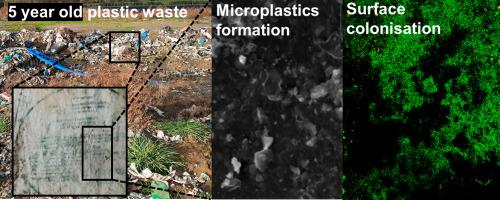Science of the Total Environment ( IF 8.2 ) Pub Date : 2020-11-21 , DOI: 10.1016/j.scitotenv.2020.143649 Marta Potrykus , Vladyslav Redko , Katarzyna Głowacka , Agnieszka Piotrowicz-Cieślak , Paweł Szarlej , Helena Janik , Lidia Wolska

|
Up to 25% of plastic waste in Europe is still disposed of in landfills, despite recycling efforts. The plastic waste in the landfill plot may be exposed both to abiotic and biotic degradation processes, although it is thought that most of the plastic materials tend to be resistant to biodegradation or biodeterioration even after a long time. To verify if polypropylene (PP) can undergo the process of short-term biodegradation and how this process is manifested in a municipal waste landfill, we collected a plastic sample from an already closed landfill plot estimating its age at approximately 5 years. Fourier-Transform Infrared Spectroscopy led to sample identification as PP as well as showed additional bands which are not specific to polymer structure but rather result from microbial metabolism. Differential Scanning Calorimetry was performed to examine the influence of the environmental degradation process on the degree of crystallisation of the tested PP. Moreover, significant changes on the surface of an old PP packaging were observed with Scanning Electron Microscopy (SEM) showing clear signs of PP delamination which resulted in microplastic particles formation (smaller than 5 μm in diameter). Additionally, several round and oval shaped structures were observed with SEM leading to the suspicion of biofilm formation on the PP surface. Indeed, the microorganisms were present in a vast amount on the old PP surface and possibly formed a viable biofilm as it was confirmed with fluorescence microscopy. These data show that plastic waste can be inhabited by microorganisms from the ambient environment which may probably lead to its faster degradation. However, this process should be investigated in more detail in order to shed light upon the possible risk factors of plastic biodegradation in waste landfills to the environment and human health. Even after five years, polypropylene can undergo deterioration/biodegradation in a waste landfill with viable microbial cells on its surface, possibly involved in its degradation.
中文翻译:

垃圾填埋场自然降解5年后聚丙烯结构发生变化
尽管进行了回收利用工作,但欧洲仍有多达25%的塑料废物仍被填埋处理。垃圾填埋场中的塑料废料可能同时经历了非生物和生物降解过程,尽管人们认为,即使长时间后,大多数塑料材料仍具有抗生物降解或生物降解的能力。为了验证聚丙烯(PP)是否可以进行短期生物降解,以及该过程如何在城市垃圾填埋场中表现出来,我们从一个已经封闭的填埋场收集了一个塑料样品,估计其寿命约为5年。傅立叶变换红外光谱法可将样品鉴定为PP,并显示出附加的条带,这些条带并非特定于聚合物结构,而是微生物代谢所致。进行差示扫描量热法以检查环境降解过程对测试的PP的结晶度的影响。此外,使用扫描电子显微镜(SEM)观察到旧PP包装的表面发生了显着变化,显示PP分层的明显迹象,这导致形成了微塑料颗粒(直径小于5μm)。另外,用SEM观察到几种圆形和椭圆形的结构,导致怀疑在PP表面上形成生物膜。实际上,微生物已经大量存在于旧的PP表面上,并且可能形成了可行的生物膜,如通过荧光显微镜所证实的那样。这些数据表明,塑料废物可能被周围环境中的微生物所占据,这可能导致其更快地降解。但是,应该对此过程进行更详细的研究,以弄清废弃垃圾填埋场中塑料生物降解对环境和人类健康的潜在危险因素。即使在五年之后,聚丙烯也会在垃圾填埋场的表面上发生降解/生物降解,该垃圾填埋场的表面上存在存活的微生物细胞,这可能与聚丙烯降解有关。











































 京公网安备 11010802027423号
京公网安备 11010802027423号